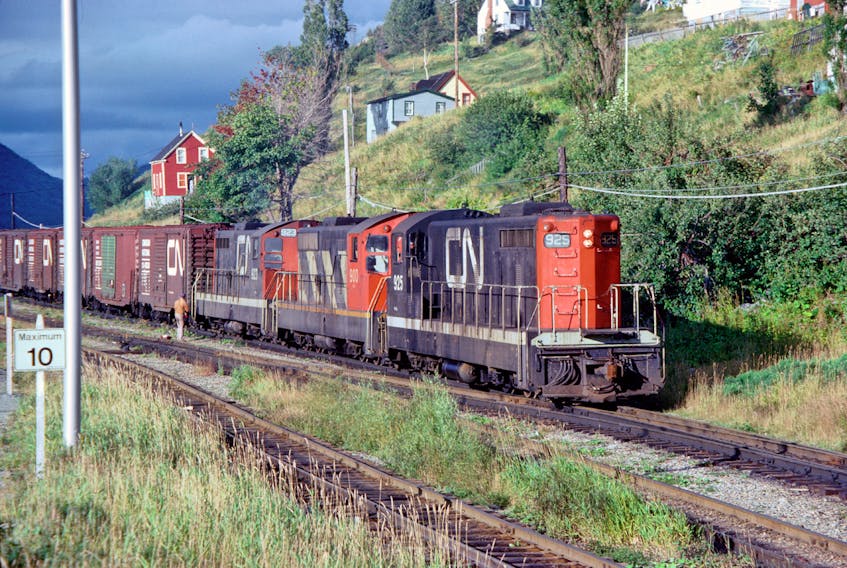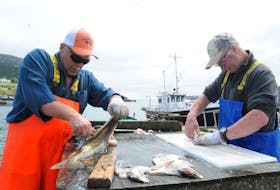Sept. 30 of this year marks 30 years since the last trains ran on the island of Newfoundland.
The railway certainly had its limitations. Chief among these was its 1,067 mm narrow gauge track. The decision to use a narrow gauge was based on cutting construction costs. Narrower gauges mean smaller and lighter equipment and infrastructure, as well as allowing track to be laid in tighter turns with the advantage of being better suited to build around geographic obstacles instead of expensively blasting or cutting through them.
By the time the mainline was completed in 1898, the narrow gauge “cost-saving measure” had racked up a substantial bill and had so many sharp curves and steep grades that the trains ran slow even by the modest standards of that time. Passenger trains running from St. John’s to Port aux Basques took 28 hours to travel about 900 km.
For all its faults, the railway in Newfoundland served its purpose: it got people around, and it did facilitate economic development in the central and western parts of the island, particularly the mining and logging industries.
Canadian National (CN) assumed ownership of the railway under the Terms of Union between Newfoundland and Canada and, to its credit, CN did embark on a number of improvements to the network on the island: diesel locomotives, new rolling stock, heavier rail on the mainline, and new larger ferries for the Nova Scotia route. Even with these improvements, travel times were slow compared to the new highways being built in the 1960s.
Standardization was discussed by CN managers but never seriously pursued. Thus, passenger trains were phased out in 1969 in favour of buses that could make the trip in nearly half the time. Freight continued well enough into the 1980s, and CN was exchanging wheelsets in Port aux Basques so standard gauge cars would run on narrow gauge and vice-versa.
Abandonment need not have been inevitable. The railway was undermined by CN and the federal government itself as the trend of economic liberalization began to take hold.
From 1978 on, CN was expected to pay for itself and promptly began separating lines administratively to determine the extent of “money-losing routes.” Operations in Newfoundland were rebranded as “Terra Transport” and little else changed aside from the adoption of intermodel containers.
The Canadian Transport Commission also modified freight rates in 1980s much to the pleasure of private shipping interests which most certainly saw a publicly subsidized rail service as unfair competition. Deregulation in 1987 was the death knell.
The railway in Newfoundland was deemed redundant and the Brian Peckford government agreed to let the railway go in exchange for approximately $800 million to improve highways, promoted as “roads for rails.”
The last revenue trains ran on Sept. 30-Oct. 1, 1988. Shortly thereafter, CN had crews dismantling the railway, leaving little left by 1990 except a handful of community displays and some abandoned maintenance sheds.
P.E.I.’s railway shared the same fate, as did other branch lines. Hundreds of good jobs were lost and an important part of the island’s transportation infrastructure had vanished.
Highway improvements did materialize; the most extensive work was expanding sections of the TCH near Corner Brook and St. John’s into a four-lane divided road. Beyond that, Newfoundland’s road network has not changed significantly.
Many secondary roads in rural areas are plagued by potholes and other defects, getting by with occasional patch-jobs.
CN’s privatization in 1996 also ended the island’s publicly run highway bus service. That service, which had its own dedicated depots and offered access to areas off the main highway, was sold to DRL which provides a much more limited service in comparison.
Both the island and Labrador need a revitalized publicly-owned transportation network that is accessible, affordable, comprehensive, and efficient, especially if we are serious about reducing our reliance on individual vehicle ownership and the environmental impact that entails.
That might even include a new railway, but that is a matter of future debate.
Sean Burton is from Corner Brook









